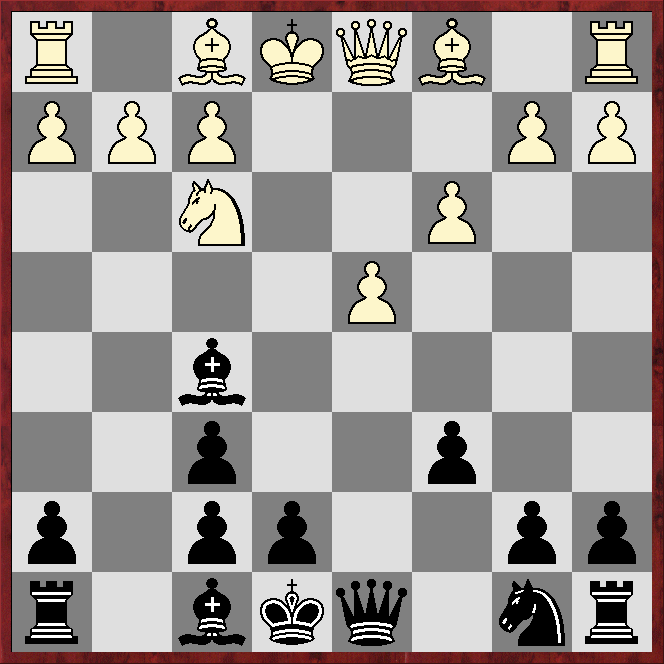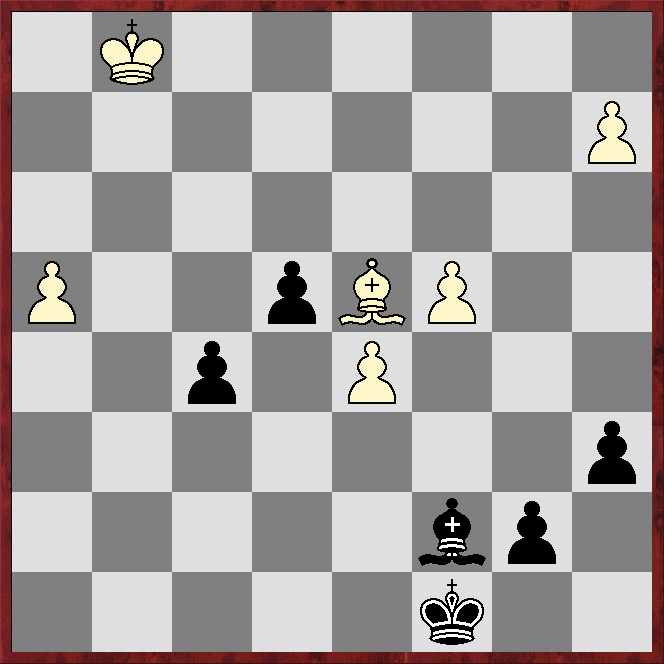Spanton (2011) - Jagwida Gasik (1752)Caro-Kann Bronstein-Larsen
1.e4 c6 2.d4 d5 3.Nc3 dxe4 4.Nxe4 Nf6 5.Nxf6+ gxf6!?
This formerly popular recapture has fallen from favour since the dramatic rise of ...exf6.
6.c3 Bf5 7.Nf3
 |
| How should Black proceed? |
*****
*****
*****
*****
*****
7...Nd7!?
More popular in ChessBase's 2025 Mega database are 7...Qc7 and especially 7...e6. Stockfish17 and Dragon1 fluctuate between the latter and the text.
8.g3!?
This is easily the commonest continuation in Mega25, despite the white light-square bishop already having an open diagonal.
8...Qb6!?
Five moves are more popular in Mega25, but there is no consensus over which is best.
 |
| How should White proceed? |
*****
*****
*****
*****
*****
9.Bg2
Consistent, but the engines prefer the more popular 9.Qe2!?, which prevents Black from interfering with White castling kingside, and also defends b2, making developing White's dark-square bishop less problematic.
9...0-0-0?!
The engines reckon this is a serious error. They want Black to play 9...Qa6 or 9...Qb5, after which they reckon White is better, but much less so than after the text, which seems to be a novelty.
10.0-0 e5 11.Nh4!?
The engines prefer getting on with it on the queenside with 11.b4 or 11.a4.
11...Be6 12.Be3!?
 |
| Is the b2 pawn poisoned? |
*****
*****
*****
*****
*****
No, is the simple answer, but the position is sharp.
12...Qxb2!?
This is Stockfish17's top choice; Dragon1 prefers capturing on d4 first, eg 12...exd4 13.Bxd4 Qxb2, but later switches to 13...Bc5.
13.Qa4!?
Possibly the wrong plan. Instead the engines suggest pushing the d pawn, either immediately or after a preliminary Rb1, eg 13.d5!? Nb6 14.Bxb6 axb6!? (14...Qxb6 15.c4 gives White the upper hand, according to the engines) 15.Rb1 with an unclear position, one line running 15...Qxc3 16.Rxb6 Bxd5 17.Bxd5 Rxd5 18.Qg4+ Kc7 19.Rfb1 Rb5 20.R1xb5 cxb5 21.Rxf6 (not 21.Rxb5?? Qc1+ 22.Kg2 Qc6+ etc) Qa1+ 22.Kg2 Qxa2, when Black is up two (doubled) pawns, but has much the weaker king, with the engines agreeing the position is completely equal.
13...Qa3 14.Bxc6!
The only way to avoid being much worse.
14...Qxa4
Not 14...bxc6?? 15.Qxc6+ Kb8 16.Rfb1 Nb6 17.Rxb6+! axb6 18.Qxb6+ Kc8 19.Qc6+ Kb8 20.Rb1+. However the engines' 14...Nb6!? seems to give equality.
15.Bxa4 a6!?
The engines reckon White is only slightly better after 15...Nb6 or 15...Kb8.
16.Bb3 Be7
The engines prefer 16...exd4!?. meeting 17.Bxd4 with 17...Bc5, and 17.cxd4 with 17...Nb6.
 |
| What should White play? |
*****
*****
*****
*****
*****
17.d5?
A fundamental misreading of the position. White should get the rooks into play, eg 17.Rab1 or 17.Rfe1. The text gains space, but it gives Black the c5 square and lets Black activate her kingside majority.
17...Bh3 18.Rfd1 f5
 |
| The position is equal, according to the engines, but Black has an obvious attacking plan, while White has to defend accurately to maintain the balance |
*****
*****
*****
*****
*****
19.Ng2?!
I rejected the engines' choice, 19.Nf3!?, because of 19...Bg4, with ...e4 to come, but the engines point out the strength of 20.d6 Bf6? 21.Bd5, when 21...e4? 22.Rdb1 gives White a very strong attack. Instead they give 20...Bxf3 21.dxe7 Rde8 with what they reckon is an equal position.
19...Bd6
White's passed pawn is firmly blockaded, and now ...f4 is a major threat.
20.f4 f6!?
This may be a little slow, although the engines reckon Black still has a slight edge. They prefer 20...Rde8 or 20...h5. After the former, White could give Black three isolanis, two of them doubled, by playing 21.fxe5, but 21...Nxe5 leaves the white king looking very vulnerable.
21.Bc2 Rdg8
The engines suggest 21...Rde8 or 21...Kb8!?
22.Rf1 Rf8!?
Black is losing time. Instead 22...e4!? takes the tension out of the position, but effectively ends Black's kingside threats. The engines suggest 22...h5!?, when they reckon 23.fxe5 fxe5 24.Bxf5 Bxf5 25.Rxf5 h4 gives Black enough play for a pawn.
23.Rf2 Rhg8 24.Re1 Rf7 25.Nh4 e4
 |
| Black's last move was forced, but it fundamentally changes the dynamics of the position |
*****
*****
*****
*****
*****
26.Ng2!? h5 27.Bd1 Rh7 28.Kh1 Nc5
Using the square that was made available to Black's pieces by 17.d5?
29.Be2 Bg4 30.Bxg4?!
This lets the black knight into d3, and helps Black improve her pawn-structure.
30...fxg4!?
The engines prefer 20...hxg4.
31.Rb1 Nd3 32.Re2 f5 33.Bd4!?
Dragon1 much prefers 33.Nh4, but Stockfish17 is indifferent.
33...Bc7
The engines suggest 33....Be7, preparing ...h4, or the immediate 33...h4!? (the idea of the latter will become apparent next move).
34.c4 h4!?
 |
| The game again becomes sharp |
*****
*****
*****
*****
*****
35.Nxh4 Nxf4! 36.Rf2
Stockfish17 slightly prefers 36.Reb2!? Dragon1 prefers the text for quite some time, but eventually agrees with Stockfish17.
36...Rxh4!?
Also equal, according to the engines, is 36...Nh5!?, eg 37.Rxf5 Nxg3+! 38.hxg3 Bxg3 39.Kg2 Bxh4, although there is plenty of play left in the position.
37.gxh4 g3 38.hxg3
Another line giving dynamic equality is 38.Rg1 Nh3 39.Rxf5 Nxg1 40.Kxg1 gxh2+ 41.Kh1 Rg4!, but again the position remains sharp.
38...Rxg3?!
Almost certainly better is the engines' 38...Nh5!?, eg 39.Rg1 Nxg3+ 40.Rxg3 (forced) Bxg3 41.Rxf5 (41.Rg2?? loses to 41...f4 and 41...Rg4) Bxh4 42.Rf4 Bd8 43.Rxe4, when White is a pawn up, but Black has complete equality, according to the engines.
39.Rg1?
39.Rb3 gives at least a slight edge.
39...Rh3+ 40.Rh2 Rxh2+ 41.Kxh2 Ne2+
 |
| How should White continue? |
*****
*****
*****
*****
*****
42.Kg2?
Blocking the rook is fatal. Instead 42.Kh3 Nxd4 43.Rg8+ holds, one point being 43...Kd7 44.Rg7+ Kd6?! 45.c5+! probably gives White the better winning chances.
42...Nxg1??
After 42...Nxd4 Black's passed pawns, supported by bishop and knight, should win easily, but the text gives a bishop-and-pawn ending that is very difficult for Black.
43.Kxg1
 |
| Material is level, but White can much more comfortably cope with Black's connected passers than Black can with White's far-apart passers |
*****
*****
*****
*****
*****
43...Bf4 44.Kf2 Bh6 45.Bf6 Kd7 46.Bg5!? Bg7
The pawn-ending after 46...Bxg5? 47.hxg5 is an easy win for White.
47.Ke3 Be5 48.c5 a5?!
Allowing a pawn to be fixed on a dark square does not help.
49.a4 Bb2 50.Ke2
Also winning is 50.Kf4!? Bc1+ 51.Kg3.
50...Bd4 51.Be3 Be5 52.h5 f4 53.Bd2 f3+ 54.Kf2
Not 54.Ke3?? Bf4+! 55.Kxf4 f2 etc.
54...Bd4+ 55.Be3 Bf6 56.h6 Bh4+ 57.Kf1 Bf6 58.h7 Kc7!?
This is Stockfish17's top choice, briefly, which only goes to show everything loses without much chance of putting up a fight.
The game finished:
59.Bd2 b6 60.Bf4+ Kb7 61.c6+ Kc8 62.d6 1-0



















































